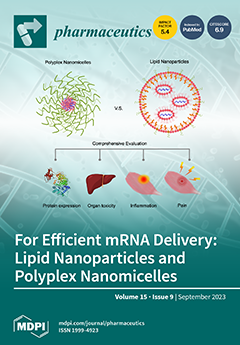The aim of this work was to evaluate the vasorelaxant and antihypertensive effects of a standardized precipitate of the hydroalcoholic extract from
Agastache mexicana (PP
Am), comprising ursolic acid, oleanolic acid, acacetin, luteolin and tilianin, among others. In the ex vivo experiments,
[...] Read more.
The aim of this work was to evaluate the vasorelaxant and antihypertensive effects of a standardized precipitate of the hydroalcoholic extract from
Agastache mexicana (PP
Am), comprising ursolic acid, oleanolic acid, acacetin, luteolin and tilianin, among others. In the ex vivo experiments, preincubation with L-NAME (nonspecific inhibitor of nitric oxide synthases) reduced the relaxation induced by PP
Am; nevertheless, preincubation with indomethacin (nonspecific inhibitor of cyclooxygenases) did not generate any change in the vasorelaxation, and an opposed effect was observed to the contraction generated by CaCl
2 addition. Oral administration of 100 mg/kg of PP
Am induced a significant acute decrease in diastolic (DBP) and systolic (SBP) blood pressure in spontaneously hypertensive rats, without changes in heart rate. Additionally, PP
Am showed a sustained antihypertensive subacute effect on both DBP and SBP for 10 days compared to the control group. On the other hand, human umbilical vein cells treated with 10 µg/mL of PP
Am showed a significant reduction (
p < 0.05) in intracellular adhesion molecule-1, compared to the control, but not on vascular cell adhesion molecule-1. In conclusion, PP
Am induces a significant antihypertensive effect in acute- and subacute-period treatments, due to its direct vasorelaxant action on rat aortic rings through NO production and Ca
2+ channel blockade.
Full article






